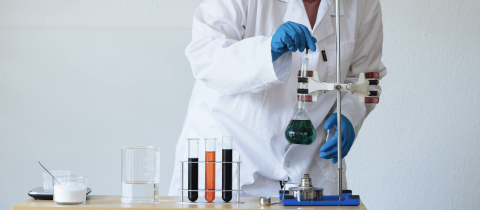Questions about milk are always interesting because, after all, it is our first food. Milk is meant to be the only sustaining food during early life and therefore it must contain all the required nutrients: water, proteins, fats, milk sugar, vitamins and minerals. Chlorophyll, the green colouring agent in plants, is not a required human nutrient and therefore evolution has not resulted in it being incorporated by the mother's body into milk. This is not to say that milk has no coloured substances in it, it does.
Some of the nutrients that are found in milk are coloured. Riboflavin or vitamin B2 which is an important enzyme cofactor has a greenish yellow hue. It is water soluble and is most readily visible in the whey that forms when the liquid portion of milk is separated from the solids, as in cheese making. The fat globules in milk can also have a yellow tinge due to carotenoids, such as beta-carotene, which stems from the diet. Beta-carotene has nutritional importance because it is a precursor to vitamin A. Summer milk from cows that dine on green pastures is yellower because grass has more beta-carotene than hay does. This is also why butter in the summer is yellow and is white in the winter.
Why is milk overwhelmingly white? This is because the tiny particles suspended in milk do not absorb any light but scatter it all towards our eyes. These particles are of two types. Tiny micelles composed of proteins bound together with calcium and phosphate ions roughly one-tenth of a micron in size, and larger fat globules, 1-5 microns in size. The larger particles scatter light more effectively. In any case, the more of these particles encountered on the light's journey through a glass of milk, the more scattering there will be. Actually, not all colours are scattered equally. Small particles, tend to scatter blue light more. In a glass of homogenized milk, there are so many fat globules and protein particles that all of the light ends up scattered to our eye. We see the glass as white. Closer scrutiny of a glass of skim milk reveals that it isn't exactly white, rather it has a bluish tint. This is because the fat globules have been removed and there are now fewer particles in suspension to scatter light. These particles are smaller and we see the effect of shorter wavelength blue light is more easily scattered. In fact, if we shine a beam of light on a glass of milk, viewing from the side produces a blue colour but a screen placed behind the milk will show a pinkish shadow. This is because the longer wavelength reddish light is transmitted. Fog lights are amber to take advantage of the fact that light with the blue colour removed is less likely to be scattered. The water droplets in fog scatter the blue components of light easily and a lot of this is reflected back to the viewer. The amber glass filters out the blue wavelengths, leaving the more penetrating longer wavelengths which then reflect off objects, enabling us to see them. So ponder over all this next time you have a glass of milk.







